Second hand fashion goes mainstream
Gone are the days when people held onto their prized possessions in their closets, stocked up their closets with expensive, rarely-used outfits

Gone are the days when people held onto their prized possessions in their closets, stocked up their closets with expensive, rarely-used outfits. The days where you could boast of having a wardrobe full of unused or stacked up clothes is passe now.
The buying population which was once dominated by Boomers have now been replaced by younger age groups. These customers have a modern mindset, they are conscious of what they buy and whom they buy from. They do not play favourites and are willing to explore the options available in the market. They are conscious of the economical and sustainable impact that their purchase might have on society.
The modern customer can be anyone from Gen X, Y, or Z. The demography consists of millennials, adults, young adults and teens. They expect value plus convenience. They want the entire package; the value, brand quality, exclusive customer benefits along with their product.
However, not everybody can afford the premium brands at their premium prices and the dawn of 2020 has seen a new scenario in the fashion industry. It is because of this reason that the pre-owned fashion industry has seen a sudden growth, says Nohar Nath, founder & CEO, Kiabza.
Gen X, Y, and Z do not mind opting for second-hand fashion wear. At pocket-friendly prices, these pre-owned clothes allow the customers the freedom to pick and choose the type of brands they would like to experiment with.
"This trend benefits the Gen Z'ers the most. Along with not having to rely on their parents' budgets for quality clothes, they get good quality clothes for their daily use at affordable rates. They can easily opt for top quality branded fashion just with their pocket money," says Nath.
The customers also have the option of selling their own clothes which are no longer of use to them. This business model can be deemed as a more refined version of a layman's garage sale.
It is a literal version of 'one man's trash is another person's treasure'. It also ensures that there is a healthy supply and demand for pre-owned products.
"According to market analysts, an estimate of 70 per cent of the world's population thrives on pre-owned fashion. Choosing to buy and sell pre-owned fashion, reduces the demand for newer clothes that is put on the environment. This leads to fewer resources being used from the environment thus, creating less waste.
"The rise in the trend of using pre-owned clothes has given birth to a generation who has an eclectic taste in fashion but is also conscious of the budgets that are spent for the same. The brands enjoy increased popularity by word-of-mouth without having to churn out fresher products every fashion season cycle; and are able to reach masses of all economic groups and strata.
"It is now that brands are truly waking up to the customer's needs. Many brands are offering to buy and repair their old collections back from the customers. These vintage lines are then resold at affordable prices in the markets. Reuse is the need of the hour, the very fact that the big-wigs of the industry are invested in this concept is indicative of the seriousness of the environmental issue. If more customers continue to embrace this current trend there will be light at the end of the tunnel in the near future," Nath concludes.
Follow us on: Facebook, Twitter, Google News, Instagram
Join our official telegram channel (@nationalherald) and stay updated with the latest headlines
